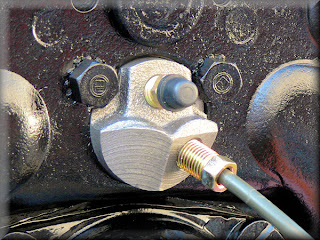This job was not that hard to do. Was it messy? Yes. There was also the smell of 40 year old lube which I found unpleasant.
If you are considering whether or not you should disassemble your steering box....go for it! Do like I did and have some items close at hand....disposable vinyl gloves (at least 20), C-fold paper towels or a roll with the towels ripped and stacked, rags and a lined garbage can to drop the greasy towels and rags into. Mineral spirits and brake cleaner are helpful.
I find it is always helpful to have a commercial aluminum baking sheet pan or half sheet pan to put under the item being worked on. That will keep the removed parts from wandering and keep the bench clean. Commercial aluminum baking sheet pans are available at restaurant supply stores for a few dollars. I clean them with either brake cleaner or soap and water.
These pans have many uses....under axle hubs when doing brake jobs, taking things apart so small parts don't get lost, etc.
 Below are the components of an early Econoline steering box. Missing from the photo are the sector shaft seal, lower bearing race, filler plug and adjusting screw lock nut.
Below are the components of an early Econoline steering box. Missing from the photo are the sector shaft seal, lower bearing race, filler plug and adjusting screw lock nut. This is the ball nut on the steering shaft. The U-shaped pieces (ball return guides) are made in two halves and they contain steel balls. On the inside of this ball nut are additional balls for a total of 62. This is a "Recirculating Ball" steering gearbox as opposed to a "Rack and Pinion" steering gear box.
This is the ball nut on the steering shaft. The U-shaped pieces (ball return guides) are made in two halves and they contain steel balls. On the inside of this ball nut are additional balls for a total of 62. This is a "Recirculating Ball" steering gearbox as opposed to a "Rack and Pinion" steering gear box.
 The side cover has three mounting bolt holes and a threaded hole for the sector shaft adjusting screw.
The side cover has three mounting bolt holes and a threaded hole for the sector shaft adjusting screw. Inside the side cover is a bushing with lubrication grooves. Notice the scratches probably caused by lack of lubrication and pitting on the sector shaft. The pitting was probably caused by moisture contamination of the old lubricant.
Inside the side cover is a bushing with lubrication grooves. Notice the scratches probably caused by lack of lubrication and pitting on the sector shaft. The pitting was probably caused by moisture contamination of the old lubricant. The sector shaft showing the signs of age. Notice the pitting and scoring and the grooves cut by the seal. I polished the shaft with emery cloth and 1000 grit paper but most of the defects will have to remain.
The sector shaft showing the signs of age. Notice the pitting and scoring and the grooves cut by the seal. I polished the shaft with emery cloth and 1000 grit paper but most of the defects will have to remain.
 This is the empty steering box. I cleaned all of the original grease out of it. No other changes were made except for a new sector shaft seal.
This is the empty steering box. I cleaned all of the original grease out of it. No other changes were made except for a new sector shaft seal. An inside view of the steering box. The race for the lower bearing for the steering shaft is center, left. The bushing for the output end of the sector shaft is right, bottom.
An inside view of the steering box. The race for the lower bearing for the steering shaft is center, left. The bushing for the output end of the sector shaft is right, bottom. New synthetic chassis lube was applied to the worm gear and worked into the interior of the nut.
New synthetic chassis lube was applied to the worm gear and worked into the interior of the nut. Notice the galled surface of the tooth in the center of the photo below. It was probably caused by over-tightening of the sector shaft's adjusting screw. You can also see the taper of the teeth.
Notice the galled surface of the tooth in the center of the photo below. It was probably caused by over-tightening of the sector shaft's adjusting screw. You can also see the taper of the teeth.The reason that "play" is removed when the adjusting screw is tightened is because the sector's teeth are pushed deeper into the taper.
 The lower bearing of the steering shaft is installed into the steering box and packed with lube. A portion of the bearing is visible on the left of center.
The lower bearing of the steering shaft is installed into the steering box and packed with lube. A portion of the bearing is visible on the left of center. The steering shaft with nut is installed into the steering box.
The steering shaft with nut is installed into the steering box. The proper setting of the steering shaft bearing adjuster (marked with a light gray/green dot) is to measure the preload with an in-lb torque wrench to 4 - 5 inch pounds.
The proper setting of the steering shaft bearing adjuster (marked with a light gray/green dot) is to measure the preload with an in-lb torque wrench to 4 - 5 inch pounds.I made the adjustment by tightening the bearing adjuster by hand. I made the adjustment so that after there was no play in the shaft, I tightened it a bit more. Call me a "human torque wrench!"
The lock nut (marked with a dot of red paint) is tightened with a drift and hammer to insure the position of the bearing adjuster does not move.
 The inside of the steering box filled with lube.
The inside of the steering box filled with lube. The Ford Shop Manual calls for a different method of assembly from this point on. They want the sector adjusting screw and shim installed on the sector followed by the side cover. This assembly is supposed to be installed as a single unit.
The Ford Shop Manual calls for a different method of assembly from this point on. They want the sector adjusting screw and shim installed on the sector followed by the side cover. This assembly is supposed to be installed as a single unit.I decided a better method would be to fill the inside of the steering box with as much lube as possible with the sector installed.
 I then installed the adjusting screw and shim onto the end of the sector and packed even more lube into the remaining cavities.
I then installed the adjusting screw and shim onto the end of the sector and packed even more lube into the remaining cavities. The inside of the side cover is coated with lube and a new homemade gasket is installed. When the cover was installed, lube squeezed out to further insure no air pockets were left in the box.
The inside of the side cover is coated with lube and a new homemade gasket is installed. When the cover was installed, lube squeezed out to further insure no air pockets were left in the box. Below, the adjusting screw is visible entering the side cover's threaded hole. The side cover attaching bolts are then installed finger tight.
Below, the adjusting screw is visible entering the side cover's threaded hole. The side cover attaching bolts are then installed finger tight.The adjusting screw is turned counter-clockwise to draw it into the cover. There must always be lash between the ball nut and sector gear teeth during this process.
Continue backing the adjusting screw out while finger tightening the attaching bolts. When the side cover is making contact with the steering box, make sure there is still some lash between ball nut and sector gear teeth.
Then and only then can the mounting bolts be tightened with a torque wrench to 15 to 22 foot pounds. The lock nut for the adjusting screw can be installed but not tightened at this time. The mesh load is then set and the lock nut tightened. It is a lot easier to do than it takes to read all of the steps!
 The steering box is ready to be installed. If any other adjustments are necessary they can be made after the drag link is installed.
The steering box is ready to be installed. If any other adjustments are necessary they can be made after the drag link is installed.
The steering box is now ready to install! Yippee!















